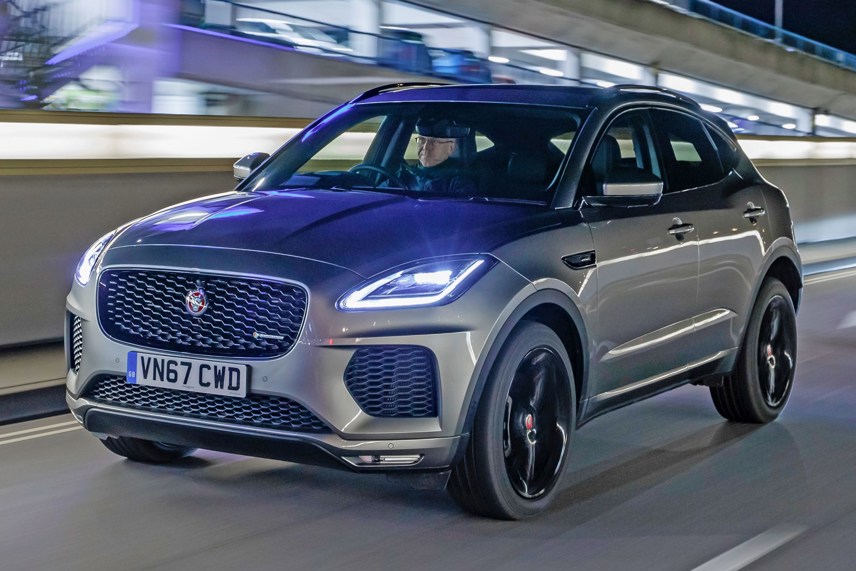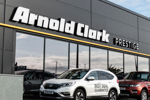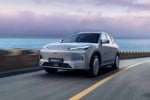Review
For a brand with a rich heritage in sports cars and motorsport, it’s perhaps ironic that Jaguar’s fastest-selling car to date has been the F-Pace SUV.
In 2017, it was largely responsible for a 20% increase in global sales, and in 2018, Jaguar is adding two smaller SUVs, starting with the E-Pace.
The all-electric I-Pace will arrive in the summer, and will become Jaguar’s first plug-in car, but the E-Pace is primed to take advantage of the strong demand for crossovers with conventional powertrains.
From a mechanical and layout perspective, the E-Pace is similar to sister brand Land Rover’s Discovery Sport and Range Rover Evoque. So perhaps the challenge, both for Jaguar’s engineers, and for sales staff on JLR’s dual-brand ‘Arch’ sites, is ensuring the customer sees and feels a vehicle more related to the ‘leaping cat’ than any Land Rover model.
The Jaguar design team, led by Ian Callum, has certainly tried to ensure the E-Pace has its own look, a little softer than the F-Pace, but with cues from the F-Type in the headlamps and the rear haunches.
Petrol or diesel 2.0-litre Ingenium engines power the E-Pace range, with various outputs to match certain price points. An entry-level D150 starts at £28,500 on the road with front-wheel drive, four-wheel drive versions start at just over £30,000, with the next most popular engine, the 4WD-only D180, at £30,790.
There’s a more powerful D240, available only with four-wheel drive and an automatic transmission, while P250 and P300 petrol versions are also auto and all-wheel drive.
The range is split into two body designs – standard and R-Dynamic – with the base E-Pace available in both, then a choice of S, SE and HSE equipment grades. There is also a First Edition grade offered in D180 and P250 during the first model year of the car.
The entry-level E-Pace comes with heated windscreen and washer jets, heated door mirrors, rain-sensing wipers, twin exhaust pipes, tailgate spoiler, automatic LED headlights, LED rear lights, 17-inch alloy wheels, two-zone climate control, cloth seats and leather steering wheel.
Safety features include autonomous emergency braking, six interior airbags, cruise control with speed limiter, driver condition monitor, lane-keeping assistant, front and rear parking sensors, rear-view camera and power child locks.
Other driving aids include hill launch assist, All Surface Progress Control (auto only), torque vectoring by braking (AWD only) and low traction launch (auto only).
Entry-level versions come with push button start, 10-inch Touch Pro dashboard screen, five-inch driver info display, 125W audio system with DAB, Bluetooth and voice control, four 12V power outlets and two USB data and charging ports, plus an eco-driving-style assistant.
R-Dynamic cars are distinguished by cosmetic changes in the styling to give it a more aggressive look.
S specification adds a signature LED daytime running light to the headlights, 18-inch alloy wheels, auto-dimming interior rear view mirror, auto-dimming, power fold, heated door mirrors with approach lights, 10-way electrically adjustable front seats, leather seats (with contrast stitching on R-Dynamic), Navigation Pro, Connect Pro Pack with Pro Services and Wi-Fi hotspot, smartphone pack with InControl apps, traffic sign recognition and adaptive speed limiter, 360-degree parking aid, rear traffic monitor and park assist.
SE includes automatic high-beam assistant, 19-inch alloy wheels, power tailgate, 14-way electrically adjustable front seats, 380W Meridian audio system, Drive Pack consisting of adaptive cruise control with queue assist, high-speed emergency braking and blind-spot assist.
The range-topping HSE has 20-inch alloy wheels, gesture tailgate opening, keyless entry, perforated leather seats and a 12.3-inch configurable digital instrument display.
The First Edition is based on the SE and adds 20-inch alloy wheels, caldera red paint, black pack exterior trim, fixed panoramic glass roof, unique interior trim treatment and head-up display.
Only D240 and P300 versions were available to drive on the launch event so for now we have only sampled these higher-performance, £40,000-plus examples.
The cabin has a clean, uncluttered design and a premium feel, with most functions found in the touch-screen display, and rotary controls for the air conditioning below. All our test cars came with the 12.3-inch digital instrument display, which only comes as standard in HSE specification, whereas in a Peugeot 3008 it’s a feature of even the entry-level car.
The automatic transmission has a sportier gear lever rather than the pop-up selector of some other automatic Jaguar models, perhaps trying to reinforce the fact that S in SUV stands for ‘sports’. On the passenger side of the centre console is a grab handle, also reminiscent of the F-Type.
The interior is roomy enough for five adults, with reasonable rear leg room. and decent rear headroom. The luggage area is also decent, with a total of 577 litres up to the retractable cover. There is a puncture repair kit rather than a spare wheel.
It’s possible to connect and charge up to five devices by USB cable, depending on specification, while the E-Pace’s Wi-Fi network, where specified, can link to eight devices.
The E-Pace feels agile, and rather firm of ride compared with other Jaguar models, although we still think it feels more compliant than rivals such as the Audi Q3. The agility certainly puts distance between how it feels compared with the related Range Rover Evoque.
 Q&A: Jeremy Hicks, managing director, Jaguar Land Rover UK
Q&A: Jeremy Hicks, managing director, Jaguar Land Rover UK
When did dealers first see the E-Pace and when will the car arrive in showrooms?
We revealed the new Jaguar E-Pace to the world via a spectacular Guinness World Record 270-degree corkscrew-like barrel roll in July last year. Order books opened following the reveal and it is available in UK showrooms now.
What are the challenges in creating an SUV range from a brand associated with sports cars and sports saloons?
Our Pace family of SUVs are true Jaguars, with years of engineering expertise going into ensuring these vehicles are instantly recognisable as a Jaguar, with all of the dynamic and performance credentials associated with the brand. As well as performance, it’s obvious from the styling of E-Pace that it takes clear design cues from its sporting brother, the F-Type.
Given the success of the F-Pace in boosting Jaguar sales, can dealers expect more of the same from the E-Pace?
The dynamic of the UK car market continues to change and the appeal of SUVs continues to grow exponentially. The introduction of the E-Pace will allow the Jaguar brand to compete in the next segment down of the SUV market. The success of F-Pace speaks for itself and we expect E-Pace to continue to drive this momentum for Jaguar, capitalising on this growing demand for SUVs.
Will it mean new customers for Jaguar, and with so many other premium crossovers available at this price point, what will be the unique appeal of the E-Pace?
The Jaguar brand stands for engaging performance and the E-Pace delivers these credentials extremely well, offering a package that blends sporty and agile performance with the added practicality and technology SUV customers demand. We believe the E-Pace has a real sense of character and will appeal to a diverse audience, bringing new, conquest, customers to Jaguar.
Which marketing tools should dealers embrace to make the most of a new product launch, such as the E-Pace, and the forthcoming I-Pace?
Increasingly, our initial communication with target customers is via our digital assets. We receive an incredibly high level of direct online enquiries – customers saying that they want someone to get in touch with them. The most effective tool retailers can use is successfully making the connection between a customer who has made a digital enquiry and turning that into a real-life showroom visit. SIMON HARRIS
Factsheet
Price: £28,500 - £50,710
Engines: 2.0-litre 249PS and 300PS petrol; 2.0-litre 150PS, 180PS and 240PS turbodiesel
Performance: 0-62mph
6.4-10.7 seconds;
top speed
120-151mph
Gearbox: 6sp manual or 9sp automatic
Fuel efficiency: 35.3-60.1mpg
Emissions: 124-181g/km CO2














Login to comment
Comments
No comments have been made yet.